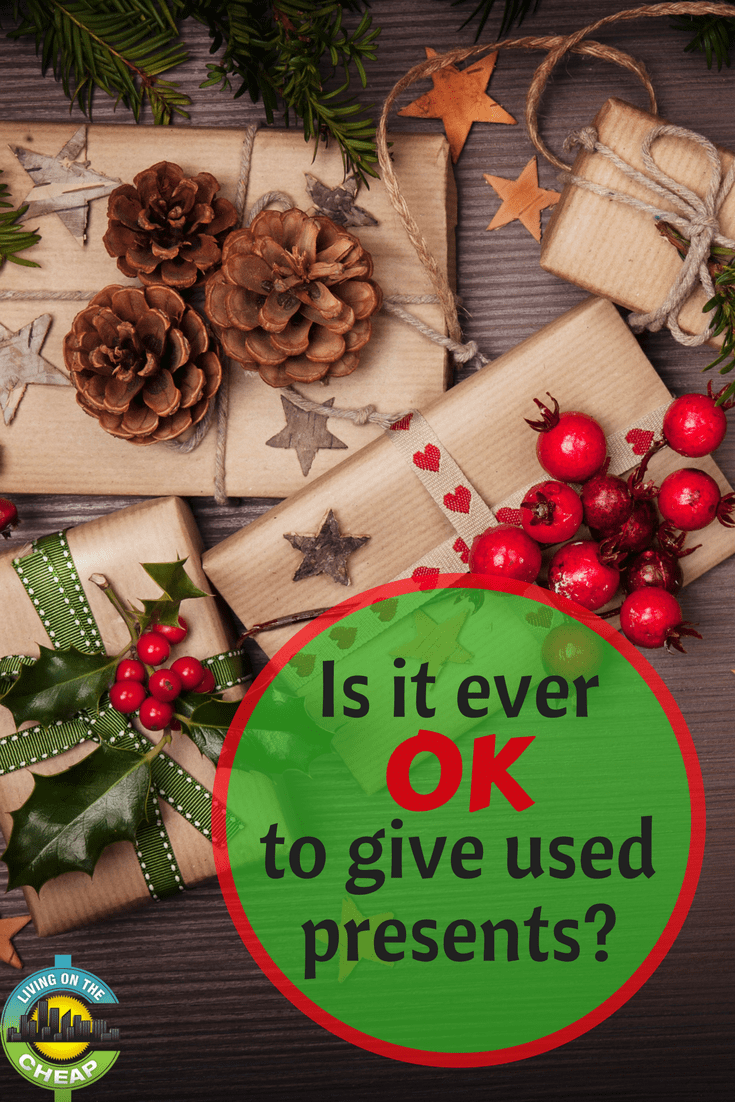Is it okay to give used items as gifts? Absolutely! The idea of gifting previously loved items is becoming increasingly popular—and for good reasons. Not only does it add a personal touch that brand-new gifts often lack, but it also supports sustainability by reducing waste.
Whether it’s that quirky vintage lamp from your favorite thrift shop or a classic novel with beautifully worn pages, these gifts come with a story and charm that simply can’t be bought off the shelf.
By choosing to give used items, you’re gifting with intention and contributing to a more sustainable world. Curious to explore this gifting trend further? Let’s dive in!

Photo: Deposit Photos
If you’re wondering if regifting a gift is okay, or buying a friend a used gift is taboo, these tips can help!
Is it rude to give someone a used gift?
Not necessarily! It can actually be a delightful surprise, showing thoughtfulness and care. Imagine gifting a vintage book to a fellow literature lover or a cherished family heirloom to a relative. These used gifts carry stories and sentimental value that new items simply cannot match.
Of course, always consider the recipient’s tastes and the condition of the gift. Clean it up, wrap it with love, and include a note! Above all, be sure they’ll appreciate your gesture.
Tips on giving used items as gifts
I have given and received used presents. (I actually refer to this as preloved gifting!) When it comes to gifting used items, there are a few tips to keep in mind:
Choose Thoughtfully
Select items that have meaning or relevance to the recipient. Consider their interests, hobbies, or needs. For example, a used cookbook from a favorite chef could be perfect for a food lover.Ensure Quality
Inspect items carefully to make sure they are in good condition. Clean and repair them if needed. A gently used item that looks new will be more appreciated.Add a Personal Touch
Personalize the gift to make it unique. You could write a heartfelt note explaining why you chose this item or include a story about its history.Creative Presentation
Present the gift in a creative way. Use attractive wrapping paper or a vintage box. Adding small details like a ribbon or handmade tag can enhance the presentation.Communicate the Value
Explain the significance of the gift. You might say something like, “I found this book and thought it perfectly aligns with your love for history.” This helps the recipient understand the thought behind the gift.Highlight Environmental Benefits
Share the eco-friendly aspect of giving used items. Mention that reusing and recycling help reduce waste, making your gift both thoughtful and sustainable.Consider the Occasion
Tailor your gift to fit the occasion. If it’s a birthday, think about what the person has been talking about recently. For a holiday, find something festive or sentimental.Be Honest and Open
If appropriate, be candid about the item’s pre-loved status. Some recipients appreciate knowing they’re getting an item with a history.Add Complementary Items
Pair the main item with a small, new accessory. For example, if you’re gifting a used teapot, include a box of tea to complete the gift.Share a Story
If the item has a known history or personal significance, share this story. It can make the gift all the more meaningful and cherished.
By following these tips, you can give gifts with personality and thoughtfulness while promoting sustainability and creativity.
Rules for shopping at consignment stores
Here are a few rules for shopping for gifts at consignment stores:
- You want the gift to be new. Or at least to appear new. Start by shopping in stores with a good reputation for consigning designer brands and insisting that clothing items are in good shape (i.e. freshly laundered, no stains or rips, no missing buttons). Chances are good many of the wardrobe pieces on these racks will still have their original tags attached. It doesn’t excuse you from doing a thorough once-over, but it does increase the odds that what looks perfect will, indeed, be perfect.
- You want the gift to fit. Most consignment stores have a no-return policy, darn your luck. This is why I browse the racks for items that don’t need an exact size. Blazers, for instance, can be a size or two off and still fit. Same with a sweater. A blouse or dress is getting riskier, and pants or shoes are a no-no.
- Pay attention to the entire store. Many consignment stores today sell more than used items. For instance, my favorite clothing shop brings in new, novelty items like scarves, a purse decoration that doubles as a glasses/iPhone microfiber cloth, leggings and a fun jewelry collection. All of these items are new but priced less than they would be at a department store.
Is regifting gifts acceptable?
Why not? You can buy a new second hand gift, or regift one of your gifts that you’ve gotten over the years. Why let a present go to waste when you can share it with others?
Wine and candles just so happen to be regifted all the time!
Julie Sturgeon contributed to this report.
If you liked this article, you may also be interested in:


We do this all the time in my family. We do it with real gifts and our yearly gag gifts, too. We all shop in thrift stores for ourselves and our families, so why should this be any different? Plus, I think it’s a lot harder to find that “perfect gift” in a thrift store or garage sale than it is to just find something off a retail store shelf…so it means more to me!
I agree with JulieCC. Many of my friends love vintage finds and I have given (and gotten!) many treasures from thrift stores as gifts.
You have to keep an eye out all year long and know what people like / collect. It feels like a big score when you find, for example, another vintage cup and saucer that a girlfriend collects.